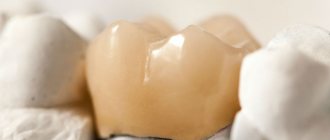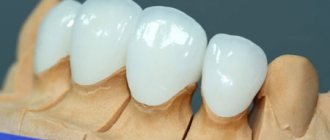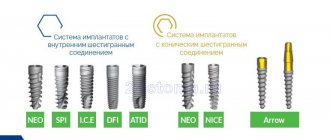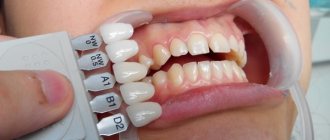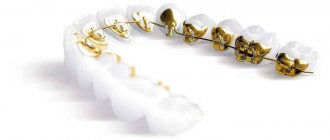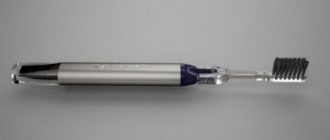Metal-free crowns made of ceramics (ceramic bridges) or zirconium dioxide are the most popular. Their popularity is not affected by either high prices or economic crises. It's all about the numerous advantages of such structures - these are the best fixed dentures.
Main characteristics
Metal-free crowns include products made from:
- plastics are cheap, but fragile, quickly stain and crack, usually used for temporary prosthetics;
- ceramic composite – consist of composite materials and ceramics;
- ceramics or porcelain - inorganic material obtained by processing nitrides, metal oxides, borides, carbides at high temperatures;
- zirconium dioxide (oxide) - similar in strength to metal, and in aesthetics - similar to ceramics.
When people talk about metal-free orthopedic structures, they usually mean zirconium dioxide and ceramics. The technology for prosthetics with these materials was developed in the 80s of the 20th century, but they began to be used on a large scale in the last ten years.
Despite the high cost, metal-free crowns are very popular
Sometimes patients confuse the concepts “metal-free” and “bimetallic”. The latter term means prostheses made from an alloy of two or more metals: gold, nickel, platinum, chromium, palladium, etc.
Price review
- High-quality dental ceramics are made in China and Germany. Installing it on a high-quality cobalt-chromium base under the guidance of a highly qualified dentist-prosthetist and dental technician will cost approximately 6 thousand rubles per tooth. At the same time, there are cheap Russian and Belarusian analogues, which is why the price of one new crown can drop to 4.5 thousand.
- If the patient does not want a metal base, but an alloy of gold with palladium or platinum, then it is worth considering the additional cost of gold per gram. Such a new thing will cost about 17 thousand.
- The cost of temporary crowns is negotiated separately.
Indications and contraindications for prosthetics
The installation of metal-free crowns and bridges is recommended in the same cases as prosthetics with bimetallic or metal-ceramic structures. Therefore, the main indications for prosthetics with porcelain and zirconium products are as follows:
- severe tooth decay: 2/3 of the height or ½ of the chewing surface or cutting edge;
- absence of one or more units;
- correction of wedge-shaped defects and other non-carious lesions;
- chips and fractures of the tooth crown;
- visual elimination of the curvature of the dentition.
In addition to general indications, there are specific ones. These include cases when it is impossible to install bimetallic crowns on teeth. This:
- Allergy to metal alloys. For patients with hypersensitivity, metal-free bridges and crowns are the only prosthetic option.
- High demands on the aesthetics of artificial crowns. The average person cannot distinguish ceramics and zirconium oxide from natural teeth, while structures made of bimetals are noticeable to outsiders. Even ceramic coating does not help - the metal frame is visible through the cladding.
Metal-free ceramics are an ideal option for prosthetics of anterior teeth
. There are also contraindications:
- pregnancy and lactation;
- systemic diseases of the body in the acute stage;
- osteoporosis;
- inflammatory pathologies of the oral mucosa;
- serious defects of the maxillofacial area - deep and open bite, dysfunction of the temporomandibular joint.
Dentures are also not advisable for bruxism - involuntary grinding of teeth during sleep. However, the disease is not considered an absolute contraindication - dentists make mouth guards that will protect the crowns from abrasion at night. Plus, the management of the clinic does not provide a guarantee for prostheses to such patients.
To install a metal-free crown, less hard tissue is ground down than for a metal-ceramic crown.
Manufacturers
The price lists of dental clinics offer products from the following manufacturers:
- Noritake - metal-ceramic crowns from the Japanese company Kuraray Noritake Dental Inc, produced using the CAD/CAM method. The products are distinguished by high manufacturing precision and elegance.
- Vita metal-ceramic crowns are produced in Germany; production has been in operation since 1962. During manufacturing, emphasis is placed on strength qualities, which are achieved through the use of a finely dispersed coating.
- Duceram are metal-ceramic crowns made in Germany, which was one of the first to occupy this niche and continues to improve its product. The main feature of the manufactured prostheses is a reasonable price-quality ratio.
Advantages and disadvantages of prosthetics with metal-free crowns
The demand for prostheses made of zirconium oxide or porcelain is growing every year. Their popularity is explained by numerous advantages:
- Biocompatibility. There are no allergies to metal-free structures, they do not affect hard and soft tissues, and galvanic currents are excluded.
- Excellent edge seal. The border between the crown and the gum is invisible. And the edge of the prosthesis merges with your own tooth, which prevents the accumulation of bacterial plaque and the subsequent development of caries.
- Small volume of sewn fabrics. The thickness of metal-free crowns is less than that of metal-ceramic crowns. Therefore, very little enamel and dentin are removed. This eliminates the need to remove the neurovascular bundle (pulp). The approach also affects the “life” of units – teeth with nerves are stronger and less susceptible to caries.
- Preparation above the gum line. This eliminates periodontal injury and disruption of the circular ligaments of the teeth. And the crown itself lasts longer, because... exposing the edge of the prosthesis due to age-related changes in the tissues surrounding the unit is excluded.
- High aesthetics. Porcelain crowns resemble your own teeth the most. They are translucent - they transmit light and imitate the natural translucency of enamel. The performance of products made from zirconium dioxide is lower - they have an unnatural milky color, low light transmission and a small selection of color shades. True, there are translucent materials, but they are rarely used.
- Strength. In this indicator, zirconium dioxide is superior to ceramics - 1,200 MPa versus 360-400 MPa.
- Resistance to external factors. With proper care, metal-free dentures do not crumble, stain or chip. In addition, they do not conduct heat and cold, so tooth sensitivity is excluded.
- Long service life. Metal-free dentures will last 10-15 years.
Types of dental crowns
Today, dentists offer patients several types of dentures , made from different materials and having certain pros and cons.
Materials
The basis is usually a cast metal frame, which makes up the majority of the crown. Next, layers of ceramic are gradually applied and the prosthesis is fired at high temperatures. Heat treatment allows you to achieve high-quality bonding of ceramics to metal.
Various metals can be used as a base:
- metal ceramics on a cobalt-nickel alloy: for its production an alloy of cobalt with chromium and nickel is used. This is the most inexpensive option, but it can cause allergic reactions, and upon contact with the gums - blue mucous membranes,
- alloys of precious metals: gold, platinum, palladium. Their proportions can vary, but a larger percentage is gold. The structures are distinguished by their high price and long service life - from 15 years or more. Their use is more preferable, because gold’s composition is most compatible with the human body: it does not cause rejection or allergic reactions, and helps to achieve a more natural color for the prosthesis.
Crowns with shoulder mass are included in a separate group. With such crowns, the outer ceramic is slightly bent at the base, so that the metal underneath is covered. In this way, better aesthetics are achieved during prosthetics and there is no contact with the gum.
On a note! Before choosing a treatment method, patients often ask the question: “how much does a metal-ceramic crown cost?” The cheapest option, made from an alloy of cobalt and chromium, will cost from 5-7 thousand rubles. The cost of gold alloys with palladium impurities starts from 12 thousand. When using an all-gold frame, the price will reach 15-17 thousand rubles.
Mounting options
Metal-ceramic crowns can be used as an independent prosthetic option if you need to restore one tooth, or be present as part of other prostheses. For example, a fixed bridge (dental bridge) or a classic removable denture.
Fixed prosthetics involves the use of crowns or bridges made of metal ceramics. They successfully restore teeth and restore their aesthetics in cases of severe destruction, in the absence of one or more teeth. Such products will be the most reliable and optimal in terms of price and quality.
In addition, metal-ceramics also implies prosthetics on implants. In this case, not living teeth, but artificial metal roots are used as support. They are fixed in place of the tooth roots, that is, they are attached inside the jaw bone. This combination is considered more reliable than fastening it on your own teeth. The implant will last for decades, and in the event of loss or destruction of the prosthesis, only the crown will need to be replaced.
Crown for one tooth
A metal-ceramic crown for one tooth is used to restore the upper part destroyed by caries or damaged by cracks and chips. Single denture structures differ in the method of fixation and materials of manufacture.
The choice of crown attachment method is carried out taking into account the degree of preservation of the tooth root:
- if the roots are not damaged and more than 50% of the coronal part is preserved, then there is no need to use auxiliary structures for installation. The prosthesis is attached to a previously depulped, filled and ground tooth;
- in case of complete destruction of the coronal part and satisfactory condition of the root system, the prosthesis is fixed by installing a pin. This is a rod that is installed in the root canal and cemented to increase stability;
- in the complete absence of a unit in the dentition, the prosthesis is installed using the implantation technique. The artificial root ideally replaces the natural one in functionality and is a reliable support for the crown.
Regardless of the type of fixation, a very universal procedure is the installation of a single crown. It is made individually for each patient according to an impression and only after fitting and adjustment is fixed to the selected support.
Crowns for all teeth
If two or more units in a row are missing in the dentition, then the prosthesis is made in the form of a bridge. It can be installed only if there are healthy teeth on both sides of the defect or at least intact roots that can act as a support.
This is interesting: Abutments for implants - what are they: types, features of implantation
Metal-ceramic crowns on all teeth are fixed as follows:
- the outer units are ground;
- if there is no coronal part, a pin is installed;
- The prosthesis is installed on the prepared supports.
During the production of permanent structures, it is possible to install temporary ones. As a rule, they are made of plastic and are low in cost.
Porcelain or ceramic
All-ceramic metal-free dentures are considered the most aesthetic. They best imitate natural teeth and do not lose their properties even after a long time. However, ceramic is a very fragile material and may not withstand heavy chewing forces. Therefore, they are usually placed on the front row of teeth. The disadvantages include the high price of the products.
E-max crowns
Glass-ceramic (porcelain) crowns are hidden under the name E-max (Imax). They are 70% lithium disilicate.
E-max dentures are the best in terms of aesthetic indicators. They convey the natural translucency of enamel and have a wide range of material shades. These properties make it possible to produce crowns that are indistinguishable from your own teeth.
There are 2 types of E-max prostheses - IPS E-max Rpess and IPS E-max CAD. Each type has its own properties, manufacturing nuances, pros and cons.
E-max Rpess or Empress
The crowns are made of glass ceramic based on lithium silicate with the addition of leucite mineral. They are made by injection molding under high pressure and temperature. Therefore, the material is also called pressed ceramic.
Zirconium dioxide ceramic crowns
Zirconium orthopedic structures are manufactured using CAD/CAM technology. In terms of strength, they have no equal among metal-free prostheses. Their strength reaches 900 MPa. Therefore, even large bridges (4 or more units in length) can easily withstand chewing loads and do not break or fly off.
However, there is a nuance - the frame of the crowns is cast from a single block of zirconium dioxide. And after that, layers of porcelain are applied to it, conveying the natural shade of the teeth. The strength of the cladding is only 100 MPa, so chipping of the ceramics often occurs.
Another disadvantage is the worst aesthetics. Zirconium prostheses transmit little light and are painted in an unnatural bright milky shade. Therefore, single crowns stand out strongly against the background of your own teeth.
The strength of zirconium crowns reaches 900 MPa
Recently, problems with chipped veneers and unsatisfactory aesthetics have been solved by making orthopedic structures from monolithic zirconium blocks with translucency or with gradients of color and transparency (pre-painted).
But translucent and pre-colored zirconia blocks are rarely used in dental laboratories. More often, patients are fitted with white, opaque zirconium prostheses.
Installation and stages of prosthetics
The progress of prosthetics depends on the type of material and the method of manufacturing the structure - using CAD/CAM technology or injection molding. But the preparation for installation is the same. It consists in:
- examination of the oral cavity;
- taking X-ray photos - to determine possible pathologies, the condition of the periodontium and periodontium in the prosthetic area;
- sanitation – treatment of identified diseases, removal of tartar;
- grinding teeth for crown thickness - the volume of tissue ground depends on the type of prosthesis and varies from 0.3 mm to 2 mm.
The color of the crowns is selected individually depending on the shade of the patient’s teeth.
During treatment and sharpening there will be no pain - the doctor administers anesthesia. If the tooth is severely damaged, it is restored with a core insert. It is important that it is made of ceramic - the metal shines through porcelain and zirconium products.
Next, the orthopedic dentist takes impressions. He does this manually or using an intraoral scanner. In the first case, an impression mass is applied to the teeth, after which it hardens, impressions are formed. They will be used to make a bridge or crown. In the second option, the data is read by an intraoral camera. Afterwards they are transferred to a computer, where a three-dimensional electronic model of the future prosthesis is compiled in a special program.
Then the frame is made - by milling or baking in a special oven. Afterwards, layers of ceramics are applied, the products are ground and polished, and the surface is painted.
At the final stage, the prosthesis is tried on and modified if necessary. And only then does the installation of a metal-free crown take place—it is attached to permanent cement.
Result after prosthetics with metal-free crowns
Manufacturing technology of metal-free ceramics
Regardless of the type of crowns, their manufacturing technology is identical:
- obtaining a jaw cast;
- scanning the resulting impression or the oral cavity itself into a computer;
- projection of the future crown;
- sharpening the base of the crown using a programmed milling machine or pressing manually;
- heat treatment of the prepared frame;
- giving the final shape, using metal-free ceramic cladding;
- coating and polishing of the crown.
Then you will have to try on the product and, if necessary, make adjustments. In general, this process does not take much time unless prior dental treatment is required.
Prosthetics of anterior and chewing teeth
Different types of metal-free orthopedic structures are designed for prosthetics of various teeth. Of course, if desired, a crown or bridge made of any material can be installed in any part of the jaw. But in order for the patient’s expectations to be met, the following recommendations are adhered to:
- It is better to use E-max glass ceramics on the front teeth - zirconium crowns differ from natural teeth;
- veneers and lumineers are made from E-max ceramics;
- if you need a bridge of 3 units on the front teeth, the best choice is E-max Rpess;
- prostheses for molars or consisting of 4 or more crowns are preferably made of zirconium dioxide;
- patients with increased aesthetic requirements should choose E-max Rpess Multi glass ceramics or monolithic translucent zirconium products;
- for crowns and bridges on implants, structures made of zirconium dioxide are suitable;
- zirconium prostheses are recommended for patients with bruxism.
To make a bridge of 3 crowns on the front teeth, it is better to choose E-max Rpess
The given recommendations are associated with different requirements for prosthetics of anterior and chewing teeth. Thus, for frontal units, aesthetics is more important, so the emphasis is on the translucency of the crowns and the abundance of shades. And the molars experience high loads, but they are almost not translucent, they are not visible - a strong structure is needed here.
Alternative to metal ceramics
If, for one reason or another, metal-ceramic products are not suitable for the patient, it is suggested to pay attention to other materials.
Solid ceramic
Metal-free ceramics create ideal aesthetics, so they are better suited for replacing front teeth located in the smile area. But it is less durable and does not always cope with significant loads, unlike metal-ceramics, which is recommended to be installed on chewing teeth. In addition, the cost of all-ceramic crowns is higher.
Zirconium
Zirconium dioxide as a frame will look advantageous on both the front and chewing teeth, because its strength is not inferior to metal, and its aesthetic properties are beyond praise. It will serve for several decades. But zirconium crowns are very expensive - special computerized equipment is used to make them, and the material itself is not cheap.
There are also plastic and metal crowns. But they should not be considered as an alternative to metal ceramics. The former are inferior in strength and aesthetics, therefore they are used as a temporary option. The latter are completely unaesthetic and are practically not used today.
Metal-ceramic crowns today remain the most popular option for dental prosthetics, as they are of high quality and excellent aesthetics. The main thing is to eliminate the possibility of allergic reactions and find a professional doctor who will install the structures at the highest level.
Care rules and service life
How long metal-free crowns last depends on the quality of the design, the material used, and how well the supporting teeth were treated. On average, glass ceramic products last 7-10 years, zirconium products last from 15 years and can last 20 years or more.
But the service life of metal-free crowns is also affected by care. It does not differ from the standard requirements for oral hygiene:
- clean plaque with a brush and remove food debris from interdental spaces with floss after each meal;
- when using floss, try not to pry off the contact area between the crown and neck of the tooth - otherwise a gap will form: excellent conditions for the accumulation of plaque and leaching of cement;
- It is better to clean dentures with a brush with soft bristles and a paste with a low level of abrasiveness (RDA within 80);
- do not chew hard foods and objects - crackers, nuts, bagels, nails, pens, etc.;
- do not open packages and bottles with your teeth;
- undergo a preventive examination every six months, and, if necessary, perform professional cleaning and adjust dentures.
With proper care, zirconium crowns can last 10-15 years
Color of metal-ceramic structures
Separately, I would like to note the advantage of metal-ceramics, due to which many patients prefer it - ceramics, which is used for the manufacture of structures, allows you to imitate the shade and structure of your own tooth enamel. Therefore, the prosthetic tooth is similar to the patient’s natural teeth. The shade is selected according to the Vita scale - the selected color will remain that way throughout its entire service life, since ceramics are not subject to darkening and do not tend to absorb dyes from drinks and food.
The only thing that can change the shade of an artificial tooth is pigmented plaque, which is easily removed with professional oral cleaning.
Prices with installation in Moscow clinics
The cost of metal-free crowns is high, and also varies depending on the type of material, manufacturing technology, and pricing policy of the clinic. Therefore, it differs in different dentistry by 1.5-2 times. So:
- a crown made of E-max ceramics costs 17-30 thousand rubles;
- ceramic veneer – 17-22 thousand rubles;
- ceramic stump inlay - 14-19 thousand rubles;
- zirconium dioxide crown – 21-27 thousand rubles;
- zirconium crown on an implant – 25-45 thousand rubles.
Prices are given including turning, taking impressions and installation. The cost of preliminary treatment is calculated individually for each patient. Also, a number of clinics do not include temporary plastic crowns in their general price list - they will cost 800-1,500 rubles.
A crown made of zirconium dioxide will cost you up to 27,000 rubles.
Metal-free prostheses made of glass ceramics or zirconium dioxide are the best choice. But only when the patient has an unlimited budget. If paying 20 thousand rubles for a crown is expensive, you should take a closer look at metal-ceramic designs - they have worse aesthetic indicators, but the products will cost 4-10 thousand rubles.
Fastening technique
Installation and fastening of the prosthesis is considered the final stage:
- When the crown is removed from the temporary cement, it is thoroughly cleaned.
- The parried tooth stump is sandblasted to provide micro-roughness.
- The final fitting is performed, and the dentist makes sure that the crown is positioned correctly and does not interfere with the normal closure of the jaws.
- Special cement is applied to the inside of the prosthesis, and the crown is placed on the tooth. Then the structure is exposed to radiation from a special lamp, which accelerates the hardening process.
- All excess parts of the cement composition are carefully removed, since even a small amount of it causes inflammation and irritation of the gums.
After just an hour, the installed denture can be subjected to the chewing process. And the greatest pressure can be applied to the crown the next day .
Fastening with locks
One of the most promising technologies in prosthetics is the fastening of crowns using locks. This fastening option makes it possible to grind down abutment teeth with minimal losses; it simplifies the procedure for removing or installing a prosthesis. The fastening of these crowns begins with the fastening of dental locks using cement, which play a supporting function, followed by the installation and fastening of the prosthesis.
Fastening the crown to implants
This type of prosthetics does not require treatment of adjacent teeth. The structure itself can be installed in several ways:
- Cement fastening, in this case, the abutment is first attached to the implanted root, then the prosthesis is attached to it using cement. This method is better suited if several crowns are being prosthetized at the same time.
- Screw fastening, in this case the prosthesis is fixed with an abutment adapter outside the oral cavity. The entire structure is then screwed to the implant using a screw passing through the hole in the crown. The canal is then closed with filling material. This option is best suited for single dentures.
Doctors' opinion
To attach a single denture to a tooth, support is required. As a support, you can use the top of your healthy tooth , a fixed implant, or the root of a stump tab.
This is interesting: How to get used to dentures: adaptation phases, accelerating the process of adaptation and restoration of diction
When installing a denture on your tooth, it is advisable to do this with a ledge. This method of prosthetics consists of creating a special step near the base of the dental tissue, then the prosthesis is put on top.
Naturally, this option of prosthetics is considered more complex. But it makes it possible to distribute the pressure on the tooth, which ultimately improves aesthetics and extends its service life. Moreover, pathology in the form of blue gums , since the metal ceramics located on the prosthesis are not subject to contact with the mucous membranes of the oral cavity.
